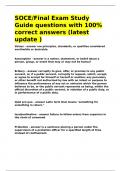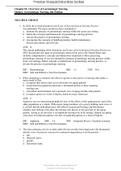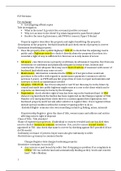VERIFIED COMPLETE SOLUTIONS GRADED A++
different types of payment mechs in econ
salary, fee for service, capitation
salary (payment mechanism) and its impact
- a fixed regular payment (will not increase income in the short run)
- can reduce work hrs/intensity of work to increase leisure time
- focus on preventative services
- encourages improved PT-physician relationship and trust (PTs know physicians are
not influenced by financial benefits)
- known for quality care and low cost of services
- discourages overutilization of physician services
- most effective payment mech for improving population health
how can work hrs and intensity be lowered by salary payment mech?
- spending more time per consultation
- seeing lower # of PTs per day
- seeing PTs w/ lower level of illness severity
- concentrating on less effort-intensive activities
- encouraging revists
fee for service (payment mech) and its impact
- pays physicians based on volume of services provided
- incentive to provide higher volume of services
- selects PTs who are likely to generate higher level of income per unit time
- encourages physicians to work long hrs to increase income
- try to differentiate services from others (increase consultation fee)
- fees for physicians are set by the market
capitation (payment mech) and its impact
,- paid fixed amount of $ per enrollee for a specific period whether the PT received care
over the defined time frame
- amount paid to physician is based on expected HC utilization of the population group
- lower ppw (no bills for each service provided, payments automatic based on the # of
enrollees)
- incentive to lower the avg # of visits per enrollee (physicians will focus on preventing
disease)
- difficult to get appts
HC as a "derived demand"
we do not want HC services for the sake of it --> we want to improve health status
- demand for HC services is related to demand for health
demand creation where utilization and demand starts at zero
- total cost is higher than the max cost people are willing to pay --> demand remains
zero
methods to increase HC services in demand creation where utilization and
demand starts at zero
- lowering cost below willingness to pay
- lower travel costs, time costs, and opportunity cost of waiting time
- improve knowledge and education of benefits of services
when HC prices are zero, consumption for more then one unit continues to
_______ satisfaction
increase
- actual price is lower than perceived price to consumers
- demand for items will increase significantly, often beyond prevalence of needs
negative prices
the providers pay consumers for using the product/service ($ or resources)
when prices are negative, consumption for more than one unit continues to
_______ satisfaction
increase
- demand curve will show higher level of consumption than justified by marginal value
bc the additional incentive
,- demand consequences will be higher bc ppl can earn extra $ just by accepting the
items even they have no intention to use the commodities (overutilization)
- short run --> make consumers aware of the value generated by consumption of the
new item
- long run --> value generated is no longer relevant as highly subsidized commodities
are likely to lead to a misuse of resources
health insurance theory
an individual will buy ins if the net benefit of buying ins outweighs the benefit of being
self-insured
- no real unit of measurement for satisfaction
assumptions of the health ins theory
- no moral hazard (customers do not change their pre-ins behavior after getting
coverage)
- individuals in the market are rational and all try to maximize their utility/satisfaction (no
adverse selection) (if net utility/satisfaction of someone w/ ins is higher than their net
satisfaction w/o ins, then the individual will buy ins)
- customers face only 2 possible outcomes --> they are sick or perfectly healthy
- illness occurs w/ a specific probability that is known to consumers
expected utility theory (for decision making under uncertainty)
framework for decision making by considering both probabilities and individual
preferences
- helps understand how rational individuals navigate uncertainty and make wiser
choices
why is 100% ins coverage not likely ?
high risk and low risk individuals do not purchase similar ins
- adverse selection, moral hazard, cost constraints, diverse preferences and needs
why are young individuals outside the private market ?
they are healthy and paying a premium feels like a waste
- if not covered by public programs/govt regulations, they are less likely to obtain ins
the demand curve for organs is _______ sloped
, negatively
- as price declines, consumers want to get a higher quantity of any goods/services
- those who need organs must obtain it at zero price
- if price of organs increase, demand will decrease
the supply curve for organs is _____ sloped
positively
- implies that the # of organs available in the market will increase if the donors are
offered a higher price (valid of organ selling is allowed)
- curve becomes vertical when sellers are not allowed to sell organs
what does the supply demand curve look like when organ selling is illegal
both will be vertical, non-intersecting, and the equality of demand and supply will not
happen at any positive level of price unless quantity demanded and supplied becomes
equal at zero price (this will not happen)
w/ supply/demand curve for organs vertical (no selling of organs), we can only
adopt policies that will lower the excess ________
demand
- will lower incentives to obtain organs illegally
types of potential policy changes for increasing supply of organs
cadaver donations - discount of drivers license renewal fee; special prize/award;
presumed consent > informed consent
- factors that will increase this: knowledge of HC delivery system, exposure to HC,
travel/burial expenses for deceased donors
living donation - linking donation w/ improvements in health status of family member;
organ exchanges (domino surgery); financial incentives (not allowed); donating gives
extra points in UNOS point system; reimburse transportation/accommodation for donors
types of potential policy changes for decreasing demand of organs
- encouraging healthy lifestyles and preventative medicine
- discourage the "marginal users of organs" from signing up as potential recipients
(those who do not need organs but the additional health benefits they will derive from
transplantation is relatively low - severely sick or elderly in poor health or person
unwilling to make lifestyle change)







